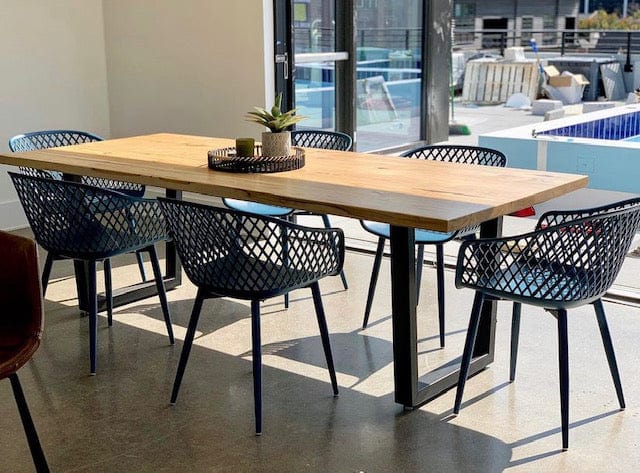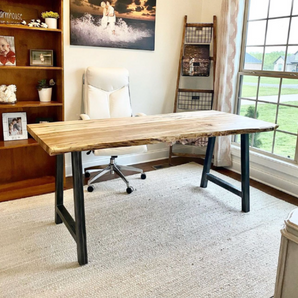How to Pick the Perfect Dining Room Table Legs for Your Home Design
How to Pick the Perfect Dining Room Table Legs for Your Home Design
Blog Article
Selecting the Perfect Dining Table: What Styles Job Best for Your Home?
Picking the ideal dining table for your home can be a nuanced procedure that stabilizes visual appeals and performance. To browse these selections effectively and discover a table that absolutely complements your home, consider the complying with elements in information.
Analyzing Your Room
Evaluating the dimensions and design of your dining area is a crucial very first step in selecting the ideal dining table. Begin by determining the length and width of the space, representing doorways, windows, and other architectural functions that might influence table placement. This guarantees that your table not only fits but also permits comfortable motion around it.
Think about the number of people you generally captivate. A table ought to accommodate your household's daily demands while supplying enough adaptability for periodic guests. As a guideline of thumb, allocate a minimum of 24 inches of table size each to make sure a comfortable dining experience.
It's additionally important to keep suitable clearance around the table. Ideally, there should go to least 36 inches between the table side and walls or other furnishings, allowing easy accessibility and activity. For areas where chairs with arms or additional storage space systems like buffets are involved, raising this clearance to 48 inches is a good idea.
Lighting and ambience play considerable roles too. Make certain that your table aligns with existing illumination fixtures or prepare for sufficient lights options. This comprehensive spatial analysis guarantees that your eating table not only fits literally but additionally harmonizes with your space's overall performance and aesthetic.
Popular Table Styles

Conventional dining tables frequently feature luxuriant information, rounded legs, and rich wood coatings, stimulating a sense of timeless style. They are excellent for homes with timeless design or those wanting to add a touch of refinement to their eating area.
Modern eating tables focus on simplicity and tidy lines, usually integrating materials like glass and steel. These tables are suitable for contemporary spaces, giving a smooth and uncluttered appearance that matches minimalist style viewpoints.
Rustic table, on the various other hand, emphasize all-natural materials and a handmade appearance - dining room table legs. They often include reclaimed timber and a distressed surface, creating a cozy and inviting environment. These tables work well in farmhouse-style homes or those looking for a comfortable, natural feel
Industrial eating tables combine raw products such as metal and timber, frequently showcasing a practical aesthetic. This design is well-suited for loft spaces or urban areas, including a touch of rugged beauty and sturdiness to the eating experience.
Each style supplies distinct benefits, making it necessary to select one that straightens with your home's overall layout and your personal preferences.
Product Choices
When choosing a table, the choice of material plays a critical role in figuring out both the table's aesthetics and performance. Timber, steel, glass, and composite materials each offer special advantages and challenges, making it necessary to line up the product with your home's decoration and way of living requirements.
Wood is a classic and versatile option, offered in selections such as oak, walnut, and mahogany. Recognized for its resilience and heat, timber enhances both typical and contemporary interiors. Nevertheless, it needs routine upkeep to protect against scratches and warping.
Metal tables, typically crafted from stainless-steel, light weight aluminum, or functioned iron, are commended for their modern-day allure and effectiveness. They are specifically matched for commercial or minimal setups however can be susceptible to damages and may really feel chilly to the touch.
Glass dining tables bring an air of sophistication and visibility, suitable for smaller spaces as they create an illusion of even more area. While simple to clean, glass can be vulnerable to smudges and requires careful handling to stay clear of chips and splits.
Composite products, such as MDF and plywood, offer affordable and customizable solutions, though they might do not have the durability of natural products. Picking the ideal material ensures your eating table is both a practical possession and a visual joy.
Sizes And Shape Factors To Consider
After establishing the ideal material for your table, the following consideration is selecting the appropriate sizes and shape to match your area. The shape of the table considerably influences the room's visual and performance. Rectangle-shaped tables, one of the most common form, are optimal for larger rooms and can accommodate a greater number of visitors. They likewise permit a much more formal eating experience. Conversely, rounded tables foster a feeling of intimacy and are superb for smaller eating areas, urging conversation by removing corners and making every person feel similarly included.
Size is just as essential and need to be dictated by both the room's measurements and the variety of people you plan to seat consistently. Generally of thumb, designate at the very least 24 inches of table width each to make sure comfy eating. Additionally, think about the table's clearance area: there need to go to least 36 inches between the table edge look at this web-site and the walls or various other furnishings. This makes certain that restaurants can walk around easily without feeling cramped. Prolonging tables use adaptability if you regularly host weblink larger gatherings, providing additional seating when needed without occupying extra space daily. Choosing the best sizes and shape guarantees both functionality and visual harmony in your dining area.
Matching Your Design
Choosing a table that integrates with your existing decoration is pivotal in developing a cohesive and welcoming area. Begin by evaluating your present interior decoration style, whether it be contemporary, traditional, rustic, or diverse. The table need to match the total aesthetic, not take on it. A sleek, minimal table with clean lines is suitable for a modern home, while a vintage, elaborate table matches a much more typical setting.
If your design includes cozy tones and all-natural products, consider a wooden table to enhance the organic feel. On the other hand, a glass or steel table might be extra ideal in a room controlled by cool colors and industrial elements.
Texture plays a vital function also. A rough-hewn, redeemed timber table can add character to a rustic space, while a polished marble surface can elevate an elegant dining area. Take into consideration the range and proportion of the table in relation to the room dimension and existing furnishings. A well-matched dining check it out table not only boosts aesthetic charm but also improves the general dining experience.

Final Thought
Choosing the ideal dining table requires cautious factor to consider of room, design, products, shape, and size (dining room table legs). Conventional tables complement traditional insides with abundant timber coatings, while modern-day tables match contemporary settings through glass and metal. Rustic designs introduce warmth through natural materials, and industrial styles enhance urban atmospheres with raw aspects. Balancing the dining table with existing design makes sure both capability and aesthetic charm, adding to a cohesive and visually pleasing dining area.
Report this page